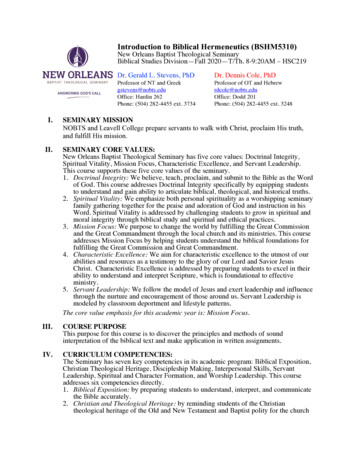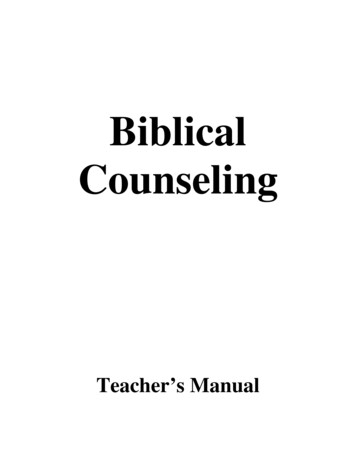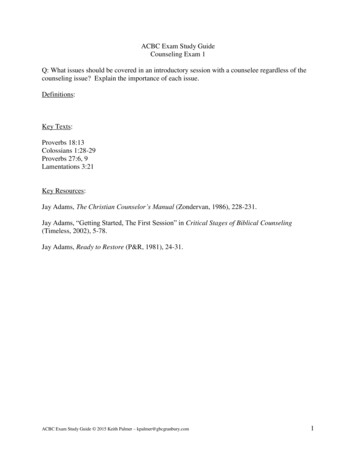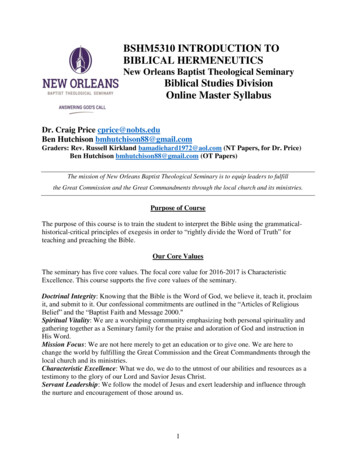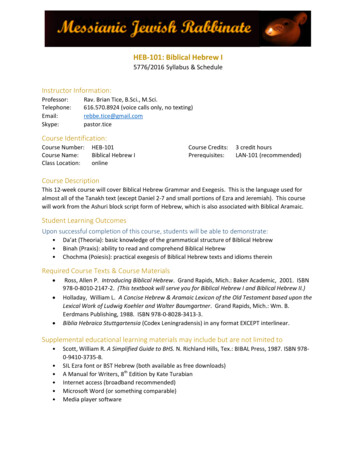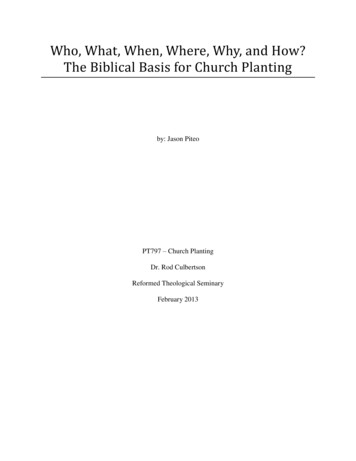
Transcription
Who, What, When, Where, Why, and How?The Biblical Basis for Church Plantingby: Jason PiteoPT797 – Church PlantingDr. Rod CulbertsonReformed Theological SeminaryFebruary 2013
Peter Wagner says that “the single most effective evangelistic methodology under heaven isplanting new churches,” but what does the Bible have to say about church planting?1 Just aswith anything else in life, we must primarily consider what Scripture has to say about the matter.Since we’re talking about the multiplication of God’s church, the importance of a biblicalunderstanding of church planting is imperative. In one sense, the Bible says nothing aboutchurch planting. The words “church” and “plant” (or any such combination of related words) arenot used together anywhere in Scripture. In another sense, the Bible says a lot about churchplanting as it describes the development of God’s kingdom on earth and the means God uses toadvance his church.Upon closer examination, we find that the Bible answers all of the most importantquestions we should be asking about church planting, namely: 1) who should plant churches, 2)what kinds of churches they should plant, 3) when and where churches should be planted, 4) whychurches should be planted, and 6) how churches should be planted. Of course, the Bible doesn’tanswer every relevant question about church planting, but it is the point at which every churchplant must begin. There are plenty of other books out there that discuss various methods andpractical considerations for church planting, but the Bible is the only worthy fundamental basisfor any church plant. We must start with the Bible and derive the rest of our questions aboutpractice from it. So, what does the Bible have to say about church planting?I.Why Plant Churches?The Need for Planting ChurchesThe question of “Why plant churches?” is the first question we must ask before we examine anyof the other questions. We need a biblical reason for planting churches before we even think1Lyle E. Schaller, 44 Questions for Church Planters (Nashville: Abingdon, 1991), 78.1
about going through with it. Even a casual student of Scripture will find that the church, thebody of Christ, is God’s appointed means of kingdom advancement. Edmund Clowney said“Jesus came to gather, and to call gatherers, disciples who would gather with him, seeking thepoor and helpless from city streets and country roads . Mission is not an optional activity forChrist’s disciples. If they are not gatherers, they are scatterers.”2 The appointed method ofkingdom advancement is to preach the good news of Jesus Christ and him crucified (1 Cor 2:2).In so doing, people will gather, and gathering God’s people leads to the growth and advancementof the church. To put it simply, people who don’t know Jesus need to get to know Jesus. So,why is it that growing the church is the best way to achieve that end? Furthermore, is churchplanting even the best practice for growing the church?Brian Vos says that the answer to that question is simple: “Church planting is essentialbecause the risen Christ has bound Himself to the assembly of His people on the Lord’s Day.”3From a practical standpoint, if it weren’t for church planting, there would be no church today.The modern church exists because the early Christians planted churches. Those churches thenplanted churches, and so on. Tim Keller maintains that planting churches is the single mosteffective method for numerical growth of the kingdom and the continual corporate renewal andrevival of existing churches.4 In his opinion, church planting trumps crusades, outreachprograms, parachurch ministries, growing mega-churches, congregational consulting, variousrenewal processes, and anything else under the sun. Those other means of kingdomadvancement aren’t inherently wrong, nor should they necessarily be abandoned, but the point is2Edmund Clowney, The Church (Downers Grove: InterVarsity, 1995), 159.Brian Vos, “The Fruitful Grain of Wheat,” in Planting, Watering, Growing: Planting Confessionally ReformedChurches in the 21st Century (eds. Daniel R. Hyde and Shane Lems; Grand Rapids: Reformation Heritage Books,2011). Kindle Edition. Chapter 1, Location 451.4Timothy J. Keller and J. Allen Thompson, Redeemer Church Planting Manual (New York: Redeemer City to City,2002), 29.32
that church planting is the most effective method to spread the gospel. The defense of this pointis not primarily that church growth researchers have confirmed this to be true (they have!). Thepoint is that the Bible, particularly the NT, describes the growth of the early church by means ofchurch planting.The apostle Paul points out the need for believers to bear Christ’s message to the world inRom 10:14-15: “How then will they call on him in whom they have not believed? And how arethey to believe in him of whom they have never heard? And how are they to hear withoutsomeone preaching? And how are they to preach unless they are sent?” 5 Preachers need to besent to proclaim God’s word and establish new churches! This is the means that God has chosento draw unbelievers to himself. Jesus’ disciples followed his commands to reach out and preachto the world doing evangelism, baptizing people as they became believers, and teaching them toobey Jesus’ commands themselves. This is how the church multiplied, as evidenced in mainly inthe book of Acts and in the Pauline Epistles, and this is how the church will continue to multiplythroughout the church age.The Motivation for Planting ChurchesThe gospel author Luke and the Apostle Paul give us the biblical evidence and description ofchurch planting, but where do we find the motivation for church planting? In the OT, we areintroduced to the concept of a man being sent by God (Abram in Gen 12:1) to establish a newgathering of people. Abram stepped out in faith, leaving the comfort of home to enter into aforeign land to live distinctively from the natives. Through Abraham and his family, all thenations of the world were to be blessed (Gen 12:2). While God’s people, Abraham’sdescendants, moved back and forth from faithfulness to rebellion, God has always maintained a5All quotations of Scripture are taken from the The Holy Bible, English Standard Version (Wheaton: Crossway,2001).3
faithful remnant to carry on the line of his promise to be witnesses to the truth. It is this sameremnant that is preserved throughout the generations, continuing into the NT era as the church.In the NT, the motivation to expand the kingdom comes directly from Jesus and can befound in all four gospel accounts and at the beginning of Acts. As the head of the church, Jesustells us in his own words why we should plant churches. He made it clear that he wanted tobuild and strengthen his church, preparing it for battle (Matt 16:18). In his popular bookPlanting Missional Churches, Ed Stetzer suggests that there are four crucial “commissioning”statements in which Jesus instructed the early church to respond to his teachings.6 One suchcommissioning relates the sending of Christ to the sending of the church. Jesus said that “as theFather has sent me, even so I am sending you” (John 20:21). What was the Father sending hisonly begotten Son to do? Jesus tells us that “the Son of Man came to seek and to save the lost”(Luke 19:10). The church, as the body of Jesus Christ, is called to pick up his earthly work andcontinue it. Jesus promises that such work will be blessed. He said “whoever believes in mewill also do the works that I do; and greater works than these will he do, because I am going tothe Father” (John 14:12).By “greater works,” Jesus meant that the disciples, working by the authority of his name,would advance the kingdom of God to a degree far beyond what Jesus had begun in his ownearthly (human) ministry. This proved to be true early on as the church grew rapidly within thefirst century alone. The book of Acts repeatedly tells us, for example, that “the word of Godcontinued to increase, and the number of disciples multiplied greatly in Jerusalem” (Acts 6:7).Note that the Bible is not talking about one big mega-church in Jerusalem, but multiple churches.Acts 16:5 says that “the churches were strengthened in the faith, and they increased in numbersdaily” (emphasis mine). And so, those greater works to which Jesus referred began as soon as6Ed Stetzer, Planting Missional Churches (Nashville: B&H, 2006), 37.4
the Holy Spirit descended upon the church at Pentecost (Acts 2:2-4) and rapidly increased as thechurches grew and multiplied.Another of Jesus’ commissioning statements is found in Mark 16:15, where he said to hisdisciples “go into all the world and proclaim the gospel to the whole creation.” Two keyelements of all of Jesus’ sending statements are that the gospel should go to the entire world (orto the nations as in other verses). The gospel is the “good news” of Jesus Christ. It is throughhim that the forgiveness of sins and life everlasting are found. It is through him thatreconciliation and a right relationship with God are found. This good news is too good forbelievers to keep to themselves, so it is imperative that they share it with others. With whom arethey to share this good news? Jesus tells us that the entire world needs to hear it.Luke 24:47 echoes the sending statement in Mark’s gospel, saying that “repentance andforgiveness of sins should be proclaimed in his name to all nations, beginning from Jerusalem.”In this verse, Jesus adds the need for repentance to accompany the proclamation of the gospel.God’s people need to know that they need to repent. Jesus also tells us that the good newsshould go forth starting from the very place it began. In the case of the disciples, that startingpoint was Jerusalem. For the Christian reader, this means that they should seek to advance thegospel message in their own neighborhoods, in their own cities. The work of missions beginsright where you are, and sometimes that’s exactly where a church needs to be planted.Luke recorded another of Jesus’ sending statements in Acts 1:8, where Jesus tells thedisciples that they will receive power when the Holy Spirit has come upon them and they will behis witnesses in Jerusalem and in all Judea and Samaria, and to the end of the earth. Again, he isemphasizing the need for the disciples to start where they are on the work of gospeladvancement. To this, he adds the crucial fact that the Holy Spirit himself, along with his divine5
power, will accompany the disciples in their work. God intends to multiply his church, so he hasgiven his own power for his people to wield in order to accomplish that task.The Great CommissionWe find the most famous of Jesus’ commissioning statements in Matt 28:18-20, the passagecommonly known as The Great Commission. The apostle Matthew records Jesus’ words to hisdisciples before he ascended into heaven. Jesus said “All authority in heaven and on earth hasbeen given to me. Go therefore and make disciples of all nations, baptizing them in the name ofthe Father and of the Son and of the Holy Spirit, teaching them to observe all that I havecommanded you. And behold, I am with you always, to the end of the age.” Many things may begleaned from this passage, which most agree is the clearest biblical support (or mandate) forchurch planting.First, Jesus has called the disciples to “disciple-making,” as opposed to what we mightcommonly think of as merely evangelism. The distinction is that disciple-making is much morecomprehensive than evangelism. Though the believer is declared righteous (justified), he mustalso be made holy (sanctified) in order to see the Lord (cf. Heb 12:14). The act of evangelism isdesigned to move the hearer to make a decision for Christ, to make a profession of faith in Jesus.While such a decision or proclamation of faith does indeed grow the kingdom, it does notinherently “make disciples.” In his book Planting Growing Churches, Aubrey Malphurs says itwell, that “conversion is meant to be germinal not terminal, the beginning not the end, of a closerelationship with Christ.”7 There need to be both decisions for Christ and disciples of Christ.Often, churches fall to one extreme or the other in their focus, but the Great Commission insistson both evangelism and discipleship.7Aubrey Malphurs, Planting Growing Churches for the 21st Century (Grand Rapids: Baker Books, 2004), 362.6
Disciple-making consists of the ongoing pouring into a person so that they are not onlyconverted, but also taught to obey all that Jesus commanded. Of course, Jesus commanded agreat many things! It is a task of the church to train people up in the obedience andrighteousness of Christ. Only the church is able to meet this need using the various means ofgrace given to it: by proclaiming the very word of God, by worshiping in Spirit and truth, byordaining elders to teach and to lead, by utilizing the multitude of gifts given to its members, byrebuking and exhorting and disciplining, and by meeting the material and physical needs of thepeople. All of these elements are essential for the church, and all are most effective in the churchsetting. This is the process of disciple-making, the process of sanctification.We must also notice this this Great Commission is not just a call to make disciples but alsoto baptize them. This is another point where the church comes into play. In Acts (e.g. Acts2:41-47) and elsewhere, it is clear that baptism means incorporation into a worshippingcommunity with accountability and boundaries.8 The church provides itself a great corrective,on the one hand looking to church history to avoid errors of the past, and on the other handlooking to its current Spirit-indwelt members to redirect itself back to orthodoxy. Stetzer pointsout that baptism is an ordinance of the local church and should take place within the context ofthe local church.9 Many but not all denominations make this their practice. Not all require thesacraments to accompany the preaching of the Word within the context of a worship service.Debate has ensued throughout the generations about whether this commissioning was onlyfor the apostles or if it was for the continuing church. Several church fathers have suggested thatthese sending statements of Christ, including the Great Commission, were for the apostles only.108Keller and Thompson, Redeemer Church Planting Manual, 30.Stetzer, Planting Missional Churches, 40. Of course, we see exceptions to this practice in Scripture. For instance,Phillip baptized the Ethiopian eunuch without anyone else present (Acts 8:38).10Stetzer, Planting Missional Churches, 38.97
The implications for such a view are huge! Certainly, while these statements of Christ weregiven to a specific people at a given time, we must consider Scripture as a living document withrelevance to God’s people from generation to generation. Therefore, we cannot disregard thiscommissioning as having expired at the close of the apostolic age. It is imperative that thechurch continues without ceasing the practice of disciple-making.II.What Kinds of Churches Should We Plant?What is a Church Plant?So the church is called to multiply itself, and the way that it has done so is to plant churches. Butwhat exactly constitutes a church plant? The churches of the first century are identifiable as agroup of people who meet together. Hence, Paul writes to the Christians who meet together inPhilippi or Corinth (e.g. Phil 1:1; 1 Cor 1:2). So a church plant is clearly more than anoccasional or ad hoc gathering of Christians; rather it is a group which is committed to eachother as a church.11 Furthermore, a church should strive to have an established leadership,examples of which we see in Acts 14:23 and Titus 1:5. Graham Beynon points out, however,that the church should be known more for its function than its form.12Functions of Early ChurchesWhere in Scripture do we find the prescribed functions for the church? According to Malphurs,the church is organized to function in two primary ways.13 The first primary function is to carryout the ordinances (sacraments) of baptism (Matt 28:19; Acts 2:41) and the Lord’s Supper (Matt26:26-28; 1 Cor 11:23-25). The second primary function is to obey the Great Commission,11Graham Beynon, Planting for the Gospel (Ross-shire: Christian Focus, 2011), Kindle Edition: Chapter 1, Location148-51.12Beynon, Planting for the Gospel, 152-53.13Malphurs, Planting Growing Churches, 25.8
which includes the evangelization14 of unbelievers and the edification of the church. Lukerecords many of the functions related to the edification of the church in one passage, in Acts2:42-47.And they devoted themselves to the apostles' teaching and the fellowship, to the breakingof bread and the prayers. And awe came upon every soul, and many wonders and signswere being done through the apostles. And all who believed were together and had allthings in common. And they were selling their possessions and belongings anddistributing the proceeds to all, as any had need. And day by day, attending the templetogether and breaking bread in their homes, they received their food with glad andgenerous hearts, praising God and having favor with all the people. And the Lord addedto their number day by day those who were being saved. (Acts 2:42-47)In this passage we find evidence of doctrinal teaching (2:42), fellowship (2:42), worship (2:42,46), prayer (2:42), benevolent giving (2:44–45), and community reaching (2:47).Doctrinal TeachingThe doctrinal teaching aspect of this passage reminds us that the church is responsible fortraining and educating its members. This is reflective of a distinct emphasis on learning theapostolic teaching (Scripture). The power and authenticity of this apostolic teaching wasconfirmed by the many signs and wonders that accompanied it. Heb 2:3-4 teaches us that thepurpose of these signs and wonders in the early church was to show the listeners the truth of thegospel message. Given this evidence, the early church believers devoted themselves to thisapostolic teaching. They were students of the word (or “people of the Book” as they werecommonly called) and they sought to understand how Scripture applied to their lives. Biblicaldoctrine was the early church’s basis for right living. This passage in Acts serves as a model forright living, a way of life that was a true blessing for believers. The modern church should payattention to the way the early church approached the study of biblical doctrine.See the “How Should Churches Be Planted?” section below for a discussion on biblically based evangelization ofunbelievers.149
FellowshipThe fellowship aspect directs us toward a model of moving members into relationships of mutualsupport and encouragement.15 People cared for, supported, and guided one another toward godlyliving. They were essential parts of each other’s lives. Their fellowship would have certainlybecome extremely intimate. Believers dug into each other’s lives as they engaged in fellowship“day by day.” As we may still find with deep fellowship in the church today, the body ofbelievers becomes family, which is a glimpse of the sort of family we will enjoy for eternity.In addition, it seems that sharing a meal together was of major importance to the believersin early church plants. Indeed, there is something special about “breaking bread” together withother believers, the model for which may be found in Jesus’ many meals with his disciples –most significantly the Passover meal on the night before he was betrayed which we now know asThe Last Supper. The phrase “the breaking of bread” may, in fact, be referring specifically to thepractice of the Lord’s Supper sacrament, given the article in “the breaking of bread.”Regardless, simply sharing a meal together reminds us of Christ’s sacrifice on behalf of hispeople. Also, there is nothing like a meal to bring God’s people together for fellowship, prayer,and the sharing of resources. Breaking bread, therefore, is an essential part of church plantingaccording to Scripture.Worship & PrayerThe worship aspect includes the preaching of the word and was typically accompanied by thesacraments. In the corporate worship setting, many of the aspects of the church are present atonce – teaching (preaching), praising, fellowship, prayer, and giving. This underscores theimportance of the Lord’s Day worship services, which should be the center piece and focal pointof every church plant. Community groups and other smaller gatherings of believers clearly have15Keller and Thompson, Redeemer Church Planting Manual, 33.10
their place (they are endorsed in Scripture – even in this passage in Acts 2:46), but the Bible’semphasis is on the weekly large group worship gathering at the temple.Prayer seems to have accompanied every gathering of believers, no matter which functionwas being observed. Constant prayer was a regular practice of every early church plant. Morespecific prayers may be in view in this text, however. “The prayers” likely alludes to an orderlyliturgy of some sort. They were probably not merely random prayers. So, we may conclude bythe plurality of prayers mentioned in this passage that worship services in particular were bathedin prayer.Benevolent GivingThe aspect of benevolent giving was a radical practice of stewardship, economic sharing, andmercy ministry within the community of believers. This aspect likely reached beyond theassembly of believers and into the community to some degree. “So then, as we haveopportunity, let us do good to everyone, and especially to those who are of the household offaith” (Gal 6:10). This teaches that the church family was to be the primary focus of the mercyministry, while aiming to “do good to everyone” as the means are available to do so. This shouldserve as a reminder to modern churches and mission works to care for the needs of believersfirst. The church today often gets this backward.Community ReachingThe evangelistic efforts of the early church were also greatly blessed. Their outreach wasaccompanied by the power of the Holy Spirit. As a result, new believers were being converteddaily. Keller points out that these conversions were not seen individualistically, but rather, when11
a person was saved, they were “added to their number.”16 They became an integral part of thecommunity of believers.Part of the reason that we see so many conversions in the early church is that their workswere accompanied by power. Unbelievers took notice of the power and were drawn to it “day byday.” Even in the most effective modern churches, we don’t see this kind of “success.” Why isthat? Granted, we don’t have apostles any longer to draw the attention of unbelievers withmiraculous signs, and yet we do still wield the power of the Holy Spirit. In practically focusedchurch planting books, they call this effect “living in a Christian bubble.” The early churchdidn’t live in a bubble. This is one of the strategic appeals of church planting, that, at least for atime, the church is much more outwardly focused and effective at community reaching.Time InvestmentAll of these aspects or functions should be center pieces for a biblical church plant. Of course,these primary functions (theological teaching, intimate fellowship, joyous worship, relentlessevangelism, and sacrificial giving) require something even more fundamental which may or maynot be obvious. It requires that believers should spend significant amounts of time togetherdoing these functions, a point which ought to be challenging for the “lone ranger” types whothink they can do church on their own (cf. Heb 10:25). These gatherings of believers were heldboth in the smaller settings of home as well as the larger settings of the temple courts.17Therefore, both small group gatherings and large group worship services are appropriate formsof worship. Early believers were together practically all the time! I pray that our modern churchcould learn from this lesson as we have so badly isolated ourselves from our life-givingcommunity in recent years.1617Keller and Thompson, Redeemer Church Planting Manual, 34.Keller and Thompson, Redeemer Church Planting Manual, 33.12
III.Who Should Plant Churches?The Model Church PlanterThe apostle Paul was the greatest missionary in history and is our single greatest example of achurch planter. In 1 Cor 11:1, Paul tells the NT reader that they should “be imitators of me, as Iam of Christ.” Certainly, Paul’s ministry is the clearest biblical model for the church planterhimself. So what did Paul do that was worthy of imitation? What did he want his readers,including us, and especially potential church planters, to imitate? Identifying the values andactions of Paul can enrich the ministry of every modern-day church planter.18To begin, Paul was personally prepared for his church planting ministry. He had receivedthorough formal training in the Scriptures (the OT) which gave him a broad understanding ofGod’s work in and through his people throughout history. His heart was focused on the mission,to reach the lost and win them for Christ (Rom 10:1). He was also vitally connected with Godvia prayer (2 Cor 12:7-9). Furthermore, he was committed to sound theology (2 Tim 4:1-5).Finally, he became prepared by stepping out into his preaching ministry in the synagogues afteronly a handful of days with the disciples (Acts 9:20–22). We are also told that Paul lived anexemplary life (1 Thess 2), enough so that he was worthy of being imitated as he himselfimitated Christ (1 Cor 11:1).Paul was also quite a gifted evangelist. He began preaching the gospel shortly after hisconversion (Acts 9:19-22). He was a “fisher of men” in two ways: he led whole families toChrist (Acts 16:25-33), and he conducted large group evangelistic meetings (Acts 13:44; 14:1;18Stetzer, Planting Missional Churches, 44.13
19:9-10).19 His method was to “cast a wide net,” but his aim was to pour into those who weremost receptive to the gospel (Acts 18:6).Scripture also teaches that Paul was an entrepreneurial leader – an excellent quality oftenthought of as necessary for visionary church planters. He had received a vision and call directlyfrom God (Acts 9:15; Rom 15:20-23). His vision was to be the apostle to the Gentiles by leadingmissionary teams into new territories to plant churches. These missionary teams engaged inevangelism, and the fruits of those labors resulted in new churches. Paul specifically selected theworkers and apprentices he wanted on his team. He was not afraid to ask others to makesacrifices for the cause of Christ (Acts 16:2-3). Of course, Paul made his own sacrifices as well.He stayed committed to fulfilling God's calling and vision even at the cost of extreme personalsacrifice (Acts 14:19-20; 2 Cor 11:23-28). He never backed down, and he never gave up. Hemaintained a thankful attitude in the face of cruel and unfair treatment by outsiders (Acts 16:25).Occasionally, Paul thought it best to disallow someone from being part of the team (Acts15:38). He also appointed permanent local leaders to lead in his stead at the churches the heplanted (Acts 14:23; Titus 1:5). The Lord provided him with the direction as to where his teamshould plant, and his ministry partners had confidence in the wisdom of his decisions (Acts 16:610). He established a reproducible pattern for church planting (“reasoning in the synagogues” –Acts 14:1; 17:2), and he deliberately planned his ministry in advance (Acts 19:21). Churchplanters should consider what “reasoning in the synagogues” will look like in their ownministries, in their own contexts. What will their “synagogues” be?Paul’s leadership was characterized by flexible, risk-taking pioneering (1 Cor 9:19-21). Heconstantly sought out new territory to expand the reach of the gospel (Rom 15:20). He wasconstantly targeting new groups (Rom 11:1), not wanting to duplicate the work of others. Not19Stetzer, Planting Missional Churches, 44.14
only was Paul a visionary leader, but he was also a pastoral leader. He often invested personallyin the lives of believers (Acts 20:31; 1 Thess 2:7-11). He was vitally concerned with the growthand development of new converts to Christ (Acts 14:22). Paul cared for many people in hisshepherd role, including his partners in ministry (2 Tim 1:2). He gladly did what he could toequip others for the work of ministry. He recognized his own strengths and weaknesses anddelegated to others according to their strengths (Titus 1:5). In fact, in order to lead this rapidlygrowing movement, he risked delegation to young Christians (Acts 16:1-3).Paul also sought kingdom advancement over his own glory. He was willing to let his bestteammates leave his team in order to be most beneficial to the kingdom of God (Acts 17:14).Paul was willing to let go of his church plants and move on to plant more churches (Acts 16:40).He had faith in God's ability to keep the churches he started strong, thus allowing him to leave(Acts 20:32). He followed the example of Barnabas, who was willing to let go of the topposition on the church planting team (Acts 13:6-12). He modeled this to the church at Antiochwhich was willing to let go of its top leaders (Acts 13:1-4). The church he planted in Ephesuswas possibly Paul’s strongest plant and the best model we have to follow for establishing newchurches (Acts 19:10). It seems that Paul himself needed special encouragement to stay in a cityfor very long (Acts 18:9-11). The longest he ever stayed in any one place was three years (Acts20:31).Biblical Qualifications for Church PlantersPaul was a model church planter, and aspiring church planters should certainly strive to imitatehim. However, Paul’s model for church planting won’t fit every situation. Admittedly, Paul’smiraculous gifts are also quite difficult to duplicate. So, what characteristics should we measureto qualify a post-apostolic church planter?15
A trait of a church planter which is extrem
We need a biblical reason for planting churches before we even think 1 Lyle E. Schaller, . 4 Timothy J. Keller and J. Allen Thompson, Redeemer Church Planting Manual (New York: Redeemer City to City, 2002), 29. . God's people need to know that they need to repent. Jesus also tells us that the good news




